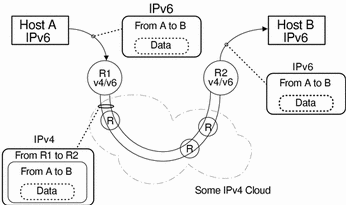Tunneling Mechanism
To minimize any dependencies during the transition, all the routers in the path between two IPv6 nodes do not need to support IPv6. This mechanism is called tunneling. Basically, IPv6 packets are placed inside IPv4 packets, which are routed through the IPv4 routers. The following figure illustrates the tunneling mechanism through routers (R) using IPv4.
Figure 15-2 Tunneling Mechanism

Different uses of tunneling in the transition are:
-
Configured tunnels between two routers (as in the figure above)
-
Automatic tunnels that terminate at the dual hosts
A configured tunnel is currently used in the Internet for other purposes, for example, the MBONE (the IPv4 multicast backbone). Operationally, it consists of configuring two routers to have a virtual point-to-point link between them over the IPv4 network. This kind of tunnel is likely to be used on some parts of the Internet for the foreseeable future.
Automatic Tunnels
The automatic tunnels have a more limited use during early experimental deployment. They require IPv4 compatible addresses and can be used to connect IPv6 nodes when there are no IPv6 routers available. These tunnels can originate either on a dual host or on a dual router (by configuring an automatic tunneling network interface), and they always terminate on the dual host. These tunnels work by dynamically determining the destination IPv4 address (the endpoint of the tunnel) by extracting it from the IPv4 compatible destination address.
- © 2010, Oracle Corporation and/or its affiliates
